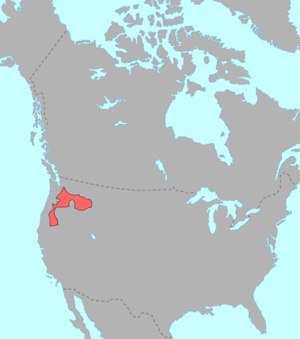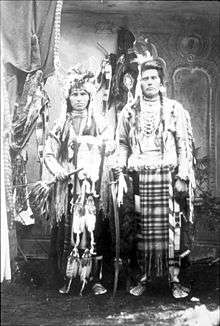Nez Perce language
| Nez Perce | |
|---|---|
| Niimiipuutímt | |
| Native to | United States |
| Region | Idaho |
| Ethnicity | 610 Nez Perce people (2000 census)[1] |
Native speakers | a handful of elders on Nez Perce and Colville Reservations (2007)[1] |
|
Plateau Penutian
| |
| Language codes | |
| ISO 639-3 |
nez |
| Glottolog |
nezp1238[2] |
Nez Perce /ˌnɛzˈpɜːrs/, also spelled Nez Percé or called Niimi'ipuutímt, is a Sahaptian language related to the several dialects of Sahaptin (note the spellings, -ian vs. -in). The Sahaptian sub-family is one of the branches of the Plateau Penutian family (which, in turn, may be related to a larger Penutian grouping). It is spoken by the Nez Perce people of the Northwestern United States.
Nez Perce is a highly endangered language. While sources differ on the exact number of fluent speakers, it is almost definitely under 100. The Nez Perce tribe is endeavoring to reintroduce the language into native usage through a language revitalization program, though at present the future of the Nez Perce language is far from assured.[3]
The grammar of Nez Perce has been described in a grammar ((Aoki 1973)) and a dictionary ((Aoki 1994)) with two dissertations (Rude 1985; Crook 1999).
Phonology

The phonology of Nez Perce includes vowel harmony (which was mentioned in Noam Chomsky & Morris Halle's The Sound Pattern of English), as well as a complex stress system described by Crook (1999).
Consonants
| Bilabial | Alveolar | Palatal | Velar | Uvular | Glottal | |||||
|---|---|---|---|---|---|---|---|---|---|---|
| central | lateral | plain | lab. | plain | lab. | |||||
| Plosive | voiceless | p | t | c | k | kʷ | q | qʷ | ʔ | |
| ejective | pʼ | tʼ | tɬʼ | cʼ | kʼ | kʷʼ | qʼ | qʷʼ | ||
| Fricative | (voiceless) | s | ɬ | ʃ | x | χ | h | |||
| Sonorant | plain | m | n | l | j | w | ||||
| creaky | m̰ | n̰ | l̰ | j̰ | w̰ | |||||
Grammar

As in many other indigenous languages of the Americas, a Nez Perce verb can have the meaning of an entire sentence in English. (This manner of providing a great deal of information in one word is called polysynthesis.) Verbal affixes provide information about the person and number of the subject and object, as well as tense and aspect (e.g. whether or not an action has been completed).
word: ʔaw̓líwaaʔinpqawtaca morphemes: ʔew - ʔilíw - wee - ʔinipí - qaw - tée - ce gloss: 1/2-3OBJ - fire - fly - grab - straight.through - go.away - IMPERF.PRES.SG translation: 'I go to scoop him up in the fire' (Cash Cash 2004:24) word: hitw̓alapáyna morphemes: hi - tiw̓ele - pááy - e gloss: 3SUBJ - in.rain - come - PAST translation: 'He arrived in the rain' (Aoki 1979)
Case
In Nez Perce, the subject of a sentence, and the object when there is one, can each be marked for grammatical case, an affix that shows the function of the word (compare to English he vs. him vs. his). Nez Perce employs a three-way case-marking strategy: a transitive subject, a transitive object, and an intransitive subject are each marked differently. Nez Perce is thus an example of the very rare type of tripartite languages (see morphosyntactic alignment).
Because of this case marking, the word order can be quite free. A specific word order tells the hearer what is new information (focus) versus old information (topic), but it does not mark the subject and the object (in English, word order is fixed — subject–verb–object).
Nouns in Nez Perce are marked based on how they relate to the transitivity of the verb. Subjects in a sentence with a transitive verb take the ergative suffix -nim, objects in a sentence with a transitive verb take the accusative suffix -na, and subjects in sentences with an intransitive verb don’t take a suffix. For example:
Ergative suffix -nim
ᶍáᶍaas-nim hitwekǘxce
grizzly-ergative he.is.chasing
‘Grizzly is chasing me’
Accusative suffix -ne
ʔóykalo-m titóoqan-m páaqaʔancix ᶍáᶍaas-na
all-ergative people-ergative they.respect.him grizzly-accusative
‘All people respect Grizzly’
Intransitive subject
ᶍáᶍaac hiwéhyem
grizzly has.come
‘Grizzly has come’ (Mithun 1999)
This system of marking allows for flexible word order in Nez Perce:
Verb–subject–object word order
kii pée-ten’we-m-e qíiw-ne ’ iceyéeye-nm
this 3→3-talk-csl-past old.man-obj coyote-erg
‘Now the coyote talked to the old man’
Subject–verb–object word order
Kaa háatya-nm páa-’nahna-m-a ’iceyéeye-ne
and wind-erg 3→3-carry-csl-past coyote- obj
‘And the wind carried coyote here’
Subject–object–verb word order
Kawó’ kii háama-pim ’áayato-na pée-’nehnen-e
then this husband-erg woman-obj 3→3-take.away- past
‘Now then the husband took the woman away’ (Rude 1992).
References
- 1 2 Nez Perce at Ethnologue (18th ed., 2015)
- ↑ Hammarström, Harald; Forkel, Robert; Haspelmath, Martin; Bank, Sebastian, eds. (2016). "Nez Perce". Glottolog 2.7. Jena: Max Planck Institute for the Science of Human History.
- ↑ "Nimi'ipuu Language Teaching and Family Learning". NILI Projects. Retrieved 2012-09-02.
- ↑ Consonant Systems of Nez Perce on www.u.arizona.edu
Bibliography
- Aoki, Haruo (1994). Nez Perce Dictionary. University of California Press. ISBN 978-0-520-09763-6.
- Aoki, Haruo (1973). Nez Perce Grammar. University of California Press. ISBN 978-0-520-02524-0.
- Aoki, Haruo. (1979). Nez Perce texts. University of California publications in linguistics (Vol. 90). Berkeley: University of California Press. ISBN 0-520-09593-6., 2, 3
- Aoki, Haruo; & Whitman, Carmen. (1989). Titwáatit: (Nez Perce Stories). Anchorage: National Bilingual Materials Development Center, University of Alaska. ISBN 0-520-09593-6. (Material originally published in Aoki 1979).
- Aoki, Haruo; & Walker, Deward E., Jr. (1989). Nez Perce oral narratives. University of California publications in linguistics (Vol. 104). Berkeley: University of California Press. ISBN 0-520-09593-6.
- Cash Cash, Phillip. (2004). Nez Perce verb morphology. (Unpublished manuscript, University of Arizona, Tucson).
- Crook, Harold D. (1999). The phonology and morphology of Nez Perce stress. (Doctoral dissertation, University of California, Los Angeles).
- Mithun, Marianne. (1999). The languages of Native North America. Cambridge: Cambridge University Press. ISBN 0-521-23228-7 (hbk); ISBN 0-521-29875-X.
- Rude, Noel E. (1985). Studies in Nez Perce grammar and discourse. (Doctoral dissertation, University of Oregon).
- Rude, Noel. (1992). Word Order and Topicality in Nez Perce. Pragmatics of Word Order Flexibility, viii, 193-208. John Benjamins Publishing.
Vowel harmony
- Aoki, Haruo (1966). "Nez Perce vowel harmony and proto-Sahaptian vowels". Language. 42 (4): 759–767. doi:10.2307/411831. JSTOR 411831.
- Aoki, Haruo (1968). "Toward a typology of vowel harmony". International Journal of American Linguistics. 34 (2): 142–145. doi:10.1086/465006.
- Chomsky, Noam; & Halle, Morris. (1968). Sound pattern of English (pp. 377–378). Studies in language. New York: Harper & Row.
- Hall, Beatrice L.; & Hall, R. M. R. (1980). Nez Perce vowel harmony: An Africanist explanation and some theoretical consequences. In R. M. Vago (Ed.), Issues in vowel harmony (pp. 201–236). Amsterdam: John Benjamins.
- Jacobsen, William (1968). "On the prehistory of Nez Perce vowel harmony". Language. 44 (4): 819–829. doi:10.2307/411901. JSTOR 411901.
- Kim, Chin (1978). 'Diagonal' vowel harmony?: Some implications for historical phonology. In J. Fisiak (Ed.), Recent developments in historical phonology (pp. 221–236). The Hague: Mouton.
- Lightner, Theodore (1965). "On the description of vowel and consonant harmony". Word. 21: 244–250.
- Rigsby, Bruce (1965). "Continuity and change in Sahaptian vowel systems". International Journal of American Linguistics. 31 (4): 306–311. doi:10.1086/464860.
- Rigsby, Bruce; & Silverstein, Michael (1969). "Nez Perce vowels and proto-Sahaptian vowel harmony". Language. 45 (1): 45–59. doi:10.2307/411752. JSTOR 411752.
- Zimmer, Karl (1967). "A note on vowel harmony". International Journal of American Linguistics. 33 (2): 166–171. doi:10.1086/464954.
- Zwicky, Arnold (1971). "More on Nez Perce: On alternative analyses". International Journal of American Linguistics. 37 (2): 122–126. doi:10.1086/465146.
Language learning materials
Dictionaries and vocabulary
- Aoki, Haruo. (1994). Nez Perce dictionary. University of California publications in linguistics (Vol. 112). Berkeley: University of California Press. ISBN 0-520-09763-7.
- "Nez Perce Literature and vocabulary". Indigenous Peoples' Literature. Retrieved 2013-09-21.
- McBeth, Sue. "Nez Perce-English Dictionary samples". Retrieved 2013-09-21.
- "Nez Perce-English Vocabulary" (PDF). Nez Perce National Historical Park. Retrieved 2013-09-21.
- Morvillo, Anthony (1895). A Dictionary of the Numípu Or Nez Perce Language. Retrieved 2013-09-21.
- "Nez Perce Language and the Nez Perce Indian Tribe (Nimipu, Nee-me-poo, Chopunnish, Sahaptin)". nativelangages-org. Retrieved 2013-09-21.
Grammar
- Aoki, Haruo. (1965). Nez Perce grammar. University of California, Berkeley.
- Aoki, Haruo. (1970). Nez Perce grammar. University of California publications in linguistics (Vol. 62). Berkeley: University of California Press. ISBN 0-520-09259-7. (Reprinted 1973, California Library Reprint series).
- Missionary in the Society of Jesus in the Rocky Mountains. A Numipu or Nez-Perce grammar. Desmet, Idaho: Indian Boys' Press. Retrieved 2013-09-21.
Texts and courses
- "Nimipuutimt Calendar and Nez Perce Tribe Language Program". Retrieved 2013-09-21.
- Aoki, Haruo. (1979). Nez Perce texts. University of California publications in linguistics (Vol. 90). Berkeley: University of California Press. ISBN 0-520-09593-6., 2, 3
- Aoki, Haruo; & Whitman, Carmen. (1989). Titwáatit: (Nez Perce Stories). Anchorage: National Bilingual Materials Development Center, University of Alaska. ISBN 0-520-09593-6. (Material originally published in Aoki 1979).
- "Nez Perce Language Courses" (Department of Foreign Languages and Literatures and American Indian Studies Program, University of Idaho). Retrieved 2013-09-21.
- Rockliff, J. A. (1915). "The Life of Jesus Christ from the Four Gospels in the Nez Perce Language :". Retrieved 2013-09-21.
- "Nez Perce language - Audio Bible stories and lessons". Global Recordings Network. Retrieved 2013-09-21.
- "Nez Perce Language Courses" (Department of Foreign Languages and Literatures and American Indian Studies Program, University of Idaho). Retrieved 2013-09-21.
- "Nez Perce Literature and vocabulary". Indigenous Peoples' Literature. Retrieved 2013-09-21.
- Watters, Mari. (1990). Nez Perce tapes and texts. [5 audio cassettes & 1 booklet]. Moscow, Idaho: Mari Watters Productions, Upward Bound, College of Education, University of Idaho.
External links
- "Haruo Aoki Papers on the Nez Perce Language". California Language Archive. Retrieved 2013-09-22.
- Nez Perce language videos, YouTube
- Phillip Cash Cash website (Nez Perce researcher)
- Nez Perce sounds
- Joseph Red Thunder: Speech of August 6, 1989 at the Big Hole National Battlefield Commemorating our Nez Perce Ancestors (has audio)
- Hinmatóowyalahtq'it: Speech of 1877 as retold by Jonah Hayes (ca. 1907) (.mov)
- Fox narrative animation (.swf)
- Nez Perce Verb Morphology (.pdf)
- wéeyekweʔnipse ‘to sing one’s spirit song’: Performance and metaphor in Nez Perce spirit-singing (.pdf)
- Tɨmnákni Tímat (Writing from the Heart): Sahaptin Discourse and Text in the Speaker Writing of X̣ílux̣in (.pdf)
- A map of American languages (TITUS project)
- Nez Percé at the Rosetta Project
- OLAC resources in and about the Nez Perce language